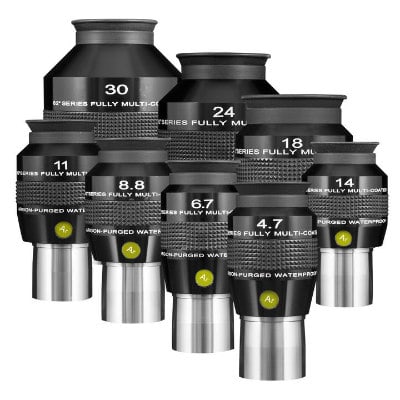This review is about my firsthand experience with the Explore Scientific 8.8 mm and 6.7 mm 82º eyepieces. I will outline why I purchased them and discuss the calculations used to determine magnification and field of view. Most of my comments about the 8.8 mm and 6.7mm ES 82ºs also apply to the other focal length ES 82ºs available.
The ES 82º is a wide view eyepiece. They offer an 82º apparent field of view, hence the name. While there are no standards on what constitutes “wide,” the industry seems to consider “wide” to be anything bigger than the 45-55º apparent field of most Plossl, Kellner, and other cheap designs commonly sold with beginner telescopes.
Eyepieces with a 60º field of view are considered wide. Eyepieces wider than 68º are considered super wide. Eyepieces wider than an 80º are ultra wide. Note that there are eyepieces that go all the way to a 120º apparent field of view.
Thus, the ES 82º eyepiece would be considered an ultra wide eyepiece. Use whatever term you like, but these are nice eyepieces.
Basic Features – 8.8 mm eyepiece
- Focal Length – 8.8 mm
- Length – 85mm
- Width – 48mm
- Weight – 8.9oz; 255g
- Barrel Size – 1.25″
- Eye Relief – 15.6mm
- Field Stop Diameter – 12.4mm
6.7 mm Eyepiece Features
- Focal Length – 6.7mm
- Length – 90mm
- Width – 43mm
- Weight – 8.0oz; 228g
- Barrel Size – 1.25″
- Eye Relief – 15.7mm
- Field Stop Diameter – 9.5mm
Overview
The ES 82º eyepieces are waterproof and purged with argon gas. Argon gas prevents moisture from intruding into the eyepiece, which could produce fogging or the internal growth of mold and fungus. Older eyepieces were nitrogen-purged; nitrogen purging is less effective as the nitrogen molecules are smaller and thus more prone to leaking from the eyepiece.
While there is no reason to have eyepieces out in the rain, if you are at a location where there is heavy dew, a waterproof eyepiece is a good idea. It also simplifies cleaning; Explore Scientific recommends simply dunking their eyepieces in a bowl of distilled water with some dish soap added to clean them.
The ES 82ºs are fully multi coated with Explore Scientific’s EMD (Enhanced Multilayer Dispersion) coatings. Explore Scientific does not provide precise information on its website concerning what their eyepieces are made out of. However, other sources report that these eyepieces contain seven elements, including crown, flint, and lanthanum glass.
The eyepieces have an eyecup, which helps you position your eye properly on the eyepiece. This can also help block stray light, which is helpful for me at my light polluted location.

The eyepiece includes a tapered safety barrel to resist accidental escape from your focuser or diagonal. The eyepieces are threaded for standard 1.25 inch filters.
The ES eyepiece comes with a one-year warranty. However, each eyepiece has a laser-etched serial number. If you register your eyepiece through ES using this serial number within sixty days of purchase, they will convert your warranty into an Explore Star extended life warranty – a lifetime, transferable warranty that covers all accidents or damages. Clearly, they have a lot of confidence in their product.
Let’s Discuss the View
I have been using Meade 26 mm, 9.6 mm, and 6.4 mm Plossl eyepieces in my Meade ETX-80, an 80mm f/5 refractor. I have been using the Orion 25 mm and 10 mm Plossl eyepieces that came with my Orion SkyQuest XT8 Intelliscope, a 203mm f/5.9 Newtonian telescope.
I had no complaints about image quality with Plossl eyepieces. They offer sharp images, but their apparent field of view is only 52º. I was interested in a wider field of view, especially for my manually tracked XT8i.
If you combine the field of view specification of an eyepiece with the magnification provided by the eyepiece in a given scope you can get an estimate of what the true field of view will be as you look through the telescope.
- Focal Length Scope / Focal Length Eyepiece = Magnification
Using the following simplified formula we can estimate the true field of view the eyepiece will provide in any given telescope.
- Apparent Field of View (AFOV) Eyepiece / Magnification Eyepiece = True Field of View
Comparison
Using my Orion XT8i with 1200 mm of focal length as an example:
An 8.8 mm Plossl eyepiece with a 52º field of view would produce 136X and a .38 degree true field of view. This is a little less than the width of the full moon, which is about .5º.
The 8.8 mm ES 82º eyepiece would produce the same 136X, but you would have a .6º field of view, or wider than a full moon.
The 6.7 mm ES 82º would produce 179X with a true field of view of about 0.46º. If I used a Plossl with the same focal length, the true field of view would be a tight 0.29º.
The wider field of view has three benefits.
1) When using a manual scope, you have more drift time for the target to remain in view.
2) You can see more when viewing larger targets, such as the Andromeda Galaxy, which is over 3º wide.
3) You can see smaller targets in the context of their surroundings; what some people call a “more immersive visual experience.”
The ES 82º’s retail price is £130 each. Are they worth it? I say yes!
There are cheaper alternatives, and I have tried a few. Unfortunately, when using shorter focal ratio telescopes, say, less than f/7, cheap wide-field eyepieces will usually show significant distortion or aberration as your view approaches the field of view’s edge.
But with the ES 82º eyepiece, using the f/5 and f/5.9 scopes, the image was clean, crisp, and sharp.
I have also used these in my f/15 Meade ETX-125, which is a Maksutov-Cassegrain design, and the image is excellent. The wide field really works well with this scope and is highly recommended for high focal ratio scopes, too.
Another benefit of these eyepieces, compared to Plossl eyepieces and many other eyepiece designs, is eye relief. This is the distance you should have your eye from the lens in order to see the entire field of view.
A typical 9 mm Plossl eyepiece has about 6 mm of eye relief. That would mean your eye would have to be almost touching the lens in order to see the full field of view. Compare this to the 15.6 mm of eye relief the ES 82º 8.8 has, and you will see why the ES 82º is much more comfortable to use.
A 6 mm Plossl has a super short 5 mm of eye relief as compared to the 15.7 mm of eye relief for the ES 6.7 82º eyepiece. And of course, that full field of view is much smaller in the Plossl.
If you use glasses, eye relief is critical. You can’t get your eye within 5 mm of the top lens of an eyepiece with glasses on. You need that extra eye relief in order to see the field of view.
I wear glasses, but not when I observe. I find it very comfortable to use with 15.6 mm and 15.7 mm of eye relief without my glasses. However, I have tested these reliefs with my glasses as well, and I am still able to see the full field of view.
What’s The Bottom Line?
The Explore Scientific 82º eyepieces are excellent and well worth the price because:
- They provide a much wider field of view than the standard Plossl
- They provide more eye relief, making them more comfortable to use, as well as more suited for people with glasses
- They are better corrected for use in lower focal ratio scopes than cheaper alternatives
To summarise, I highly recommend the Explore Scientific 82º eyepieces.
